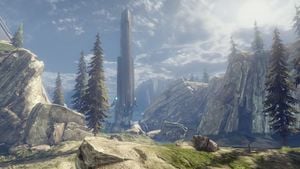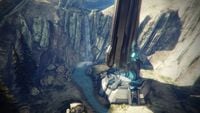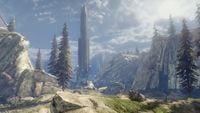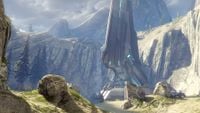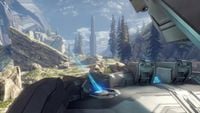Two Giants
From Halopedia, the Halo wiki
| This article's title is a callsign, an alias, or a nickname, as no proper name for the subject has been revealed. |
Two Giants is the codename for a canyon on the Forerunner shield world Requiem, named for a pair of pulse-emitting towers on either side of the canyon. It saw occupation by both the Covenant and the United Nations Space Command during the Second Battle of Requiem.
Purpose
Enigmatic and multi-purposed, spire beacons similar to these apparently frequent a number of Forerunner sites, including Halo and Shield installations, as well as the Ark megastructure. Buried within deep canyons, these towers are not only sheltered from off-world debris, but their positions allowed them to leverage the steep environment’s natural harmonics to amplify their signals when firing deep into space. Most scientists believe the spires - at their base function - act as communication channels, sending specific commands to other remote locations. The full operation and over-arching purpose of these mysterious objects, however, remains a source of speculation.[1]
History
UNSC investigation and Covenant counterattack
In February 2558, the area known as Two Giants was under Covenant control. Mountain Squad, a joint Spartan/Marine unit, was deployed to the area to investigate a mysterious signal received at Galileo Base. Their D79-TC Pelican crashed behind enemy lines and the survivors came under fire. In response, Commander Sarah Palmer deployed Spartan Fireteam Crimson to the area, where they engaged and linked up with Mountain Squad's surviving Spartans. Though the Spartans of Mountain Squad were killed, Crimson investigated the southern tower, which Dr. Catherine Halsey surmised to be the origin of the signal; at this time, the tower emitted a pulse into the sky, which alerted nearby Covenant forces.[2]
Responding to the pulse emitted by the tower, a CRS-class light cruiser arrived near Two Giants and deployed waves of Type-44 Phantoms to Crimson's position. Spartan Robert Dalton requested several Mantis assault mechs for the team, which they used to thwart the Covenant's reprisal. Eventually, UNSC Infinity's Sub-vessel 3 destroyed the cruiser and Crimson was redeployed.[3]
Later conflict
The UNSC soon established a base at the inland tower. After Covenant Supreme Commander Jul 'Mdama was reported to be present at the other tower, Fireteam Crimson was sent back to Two Giants. On their arrival, however, the Spartans encountered only Promethean constructs, which were soon reinforced by the Shipmaster's forces. 'Mdama had used the tower to teleport himself to the Fortress, a structure elsewhere on Requiem. After clearing the area, Fireteam Crimson entered a portal inside the tower, translocating them to the Fortress in pursuit of their target.[4]
The location would later be used as the basis of a War Games simulation nicknamed "Ragnarok", with the designation WAR GAMES MAP_SET/: 733-4.[1]
Production notes

|
Browse more images in this article's gallery page. |
Two Giants is the location of the Halo 4 multiplayer map Ragnarok; in-universe, the map is based on the conflict depicted in Spartan Ops, as evidenced by the presence of Mountain Squad's crashed Pelican. In the real world, the map is a remake of the Halo 3 map Valhalla, which in turn is a spiritual successor to Halo: Combat Evolved's Blood Gulch and Halo 2's Coagulation. Valhalla and Ragnarok are both named for elements of Norse mythology.
The map is an almost exact recreation of Valhalla, which is canonically set in a nearly identical canyon on Installation 00. It is thus interesting to note that Pelican Victor 398 and Mountain Squad's Pelican crashed in the same manner in the same approximate locations in their respective canyons. From a production standpoint, of course, this is due to Ragnarok being a remake of Valhalla.
Gallery
Two man cannons located on a Forerunner structure.
List of appearances
- Halo 4
- Spartan Ops (First appearance)
Sources
- ^ a b Halo Waypoint: Requiem
- ^ Spartan Ops, S1E3 - Spartan Mountain
- ^ Spartan Ops, S1E4 - Shootout In Valhalla
- ^ Spartan Ops, S1E4 - Rally Point
